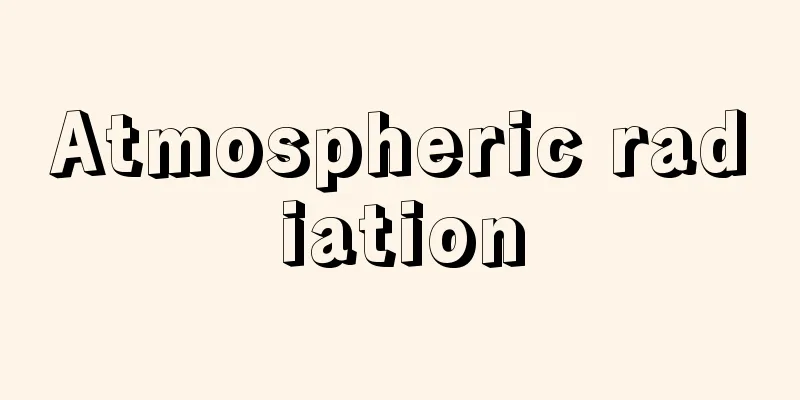Atmospheric radiation

|
This refers to radiation emitted by the atmosphere. Radiation emitted by the earth's surface is called ground radiation, and the two together are called terrestrial radiation. Meanwhile, radiation emitted by the sun is called solar radiation. Solar radiation includes ultraviolet, visible, and infrared rays, but about half of the radiant energy is visible light. Meanwhile, terrestrial radiation is infrared (long waves). It is estimated that 30% of the solar radiation that reaches the earth is reflected into space, 20% is absorbed by the atmosphere, and 50% is absorbed by the earth's surface. In this way, the earth maintains an overall balance by emitting an amount of energy equal to 70% of the solar radiation absorbed by the atmosphere and the earth's surface as infrared radiation. However, at low latitudes, more energy is received as solar radiation, and at high latitudes, more energy is lost as infrared radiation. This imbalance in energy balance acts as a kind of heat engine, driving the general circulation of the atmosphere and oceans. The reflectance of the solar radiation that reaches the Earth is called the albedo. As mentioned above, this is about 30%. The amount of radiant energy received by a unit area perpendicular to the solar radiation per unit time is called the solar constant, and its amount is 1.96 calories per minute per square centimeter. Solar radiation is absorbed in the atmosphere by ozone, water vapor, carbon dioxide, clouds, etc., and scattered by air molecules and cloud particles. On the other hand, ground radiation is also absorbed by these. However, since the atmosphere absorbs much more ground radiation than solar radiation, it can be said that the atmosphere is not heated directly by the sun but by ground radiation. In other words, the atmosphere transmits solar radiation (short waves) well but does not transmit ground radiation (long waves, infrared rays). This is called the greenhouse effect of the atmosphere. Clouds also do not transmit ground radiation, so the cooling on a clear night is greater than that on a cloudy night. However, since the albedo of clouds is large, the effect of clouds is not included in the greenhouse effect. [Hiroshi Matano] [Reference] | |Source: Shogakukan Encyclopedia Nipponica About Encyclopedia Nipponica Information | Legend |
|
大気が射出する放射をいう。地表面が射出する放射を地面放射といい、両者をあわせて地球放射という。一方、太陽が射出する放射を太陽放射という。太陽放射には紫外線、可視光線および赤外線が含まれているが、放射エネルギーの約半分は可視光線である。一方、地球放射は赤外線(長波)である。地球に到達する太陽放射のうち、空間に反射されるものが30%、大気に吸収されるものが20%、地表面に吸収されるものが50%と見積もられている。地球は、このようにして大気と地表面で吸収する太陽放射の70%と等量のエネルギーを赤外放射として空間に放出し、全体としてのバランスを保っている。しかし、低緯度では太陽放射として受け取るエネルギーのほうが多く、高緯度では赤外放射として失うエネルギーのほうが多い。このエネルギー収支の不均衡が一種の熱機関として大気や海洋の大循環を引き起こす原動力となっている。 地球に到達する太陽放射に対する反射率をアルベドという。これはすでに述べたように約30%である。太陽放射に直角な単位面積が単位時間に受ける放射エネルギーを太陽定数といい、その量は1平方センチメートル当り1.96カロリー毎分である。太陽放射は大気中でオゾン、水蒸気、二酸化炭素および雲などによって吸収され、空気分子、雲粒などによって散乱される。一方、地面放射もこれらによって吸収される。しかし、大気は太陽放射よりも地面放射をはるかに多く吸収するので、大気は太陽によって直接暖められるのではなく地面放射によって暖められるといってよい。換言すれば、大気は、太陽放射(短波)はよく通すが、地面放射(長波、赤外線)は通さない。これを大気の温室効果という。雲も地面放射を通さないので、晴天の夜間の冷却は曇天の場合より大きい。しかし、雲のアルベドは大きいので、雲の作用は温室効果には含めない。 [股野宏志] [参照項目] | |出典 小学館 日本大百科全書(ニッポニカ)日本大百科全書(ニッポニカ)について 情報 | 凡例 |
<<: Large-Scale Retail Store Law - Large-Scale Retail Store Law
Recommend
Bombing - Bakugeki (English spelling)
Generally, it refers to attacking a target by dro...
Surface tension
Usually, it refers to the force that acts on the ...
Sulfur fluoride (sulfur fluoride)
It is a compound of fluorine and sulfur, and four ...
Luis Sotelo
Spanish missionary. Franciscan priest. He played ...
Buzuk (English spelling)
A Turkish plucked string instrument. It is a lute-...
Euzkadi
…The unified name Basque originated from the Roma...
Soil type - Dojogata (English spelling)
(1) A group of soils with a common origin and form...
National Theatre
The British national theater. The term "natio...
Dhaka - Dhaka (English spelling)
The capital of Bangladesh. It is located in the c...
Ainosuke Iwata
1890-1950 A nationalist from the Taisho to early ...
Partition of Bengal
…He worked as a teacher and lawyer, and was also ...
Malayo-Polynesian
…meaning "Australian languages." Also c...
Ipponzuri (English spelling) Pole and line fishery
This is a fishing method that uses one or several...
Dermoptera
…They are also called bat monkeys. The Dermoptera...
Ueno
The former city area of Iga City, in the northwe...









